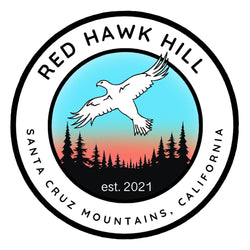Pond Restoration
Revitalizing Red Hawk Hill Orchard Pond to restore our Local Ecology & Enhance the longevity of our Community

As we practice land stewardship at Red Hawk Hill, we are working to ensure ecological health of our Sandhill Habitat that supports native communities and species on site.
Our pond on Red Hawk Hill is vernal, filling seasonally from winter precipitation, and drying up quickly in spring to early summer. Using regenerative agricultural approaches, we will restore the pond to a permanent pond. This will reestablish native species and habitat, create the regenerative opportunity to conserve and rehabilitate water and topsoil, and strengthen the overall health and vitality of our farming soil and systems.
While considering our historic landscape, we plan to grade the upper orchard to reinforce the natural flow of water in and out of the pond. We have established a no-disturbance zone, roughly 200 feet around the pond, protecting the core habitat and supporting terrestrial habitats while they re-establish. To prevent erosion, we plan to clay the south wall of our pond and apply coco coir to prevent further runoff. As we’re able to restore and hold water, we will introduce and support natives to encourage the natural pool flora and fauna.
Our pond restoration project aims to rejuvenate this vital ecosystem to enhance the habitat while ensuring a sustainable water source for our orchard and garden. This initiative is crucial for fostering biodiversity and supporting the delicate balance of our local environment.
Environmental Benefits
Restoring a healthy balanced pond habitat will encourage the revival of a number of endangered and critical native species. Ponds facilitate a complex ecological web of organism interactions: predation, mutualism, protection, reproduction, and migration. Restoring the pond habitat will create a longevity of connecting ecosystems and fostering biodiversity.
Water conservation in California is critical and severely impacts agricultural productivity. To have a permanent pond will allow us a regenerative water source for our orchard & garden, and reduce the dependency on external water supplies. Encouraging the hold of groundwater will encourage trees, native grasses, and irrigation for agriculture on site.
Using the pond and surrounding vegetation to prevent soil erosion while promoting soil health, prevent the loss of topsoil, and maintain the land’s fertility. This will encourage long-term agricultural productivity and allow habitats to flourish.
Habitat destruction has fragmented sandhill habitats throughout the Santa Cruz Mountains. As a result of habitat loss, a number of locally unique species are listed critically and federally endangered, starting with the Zayante Band-Winged Grasshopper in 1997 by USFWS. (United States Fish and Wildlife Service).
We often see the Zayante Band-Winged Grasshopper hopping around the garden and will encourage their reestablishment.
Endangered species onsite include: Santa Cruz Wallflower, Ben Lomand Spineflower, Santa Cruz Cypress, Mount Hermon June Beetle, and the Zayante Band-Winged Grasshopper.
Sensitive communities onsite include: Maritime Coast Range Ponderosa Pine, and Northern Maritime Chaparral.
Our Goals
Practice regenerative agriculture and contribute to water conservation in Zayante Hills.
Ensure Zayante Hills remain a thriving, biodiverse environment for generations to come.
Strengthen freshwater ecosystems to be a resilient source of food, nesting, and shelter where wildlife will thrive.
Grow and empower our local community to be involved land stewards and work together to revive our sandhill ecosystem.
Join us!
Invest in our vision to create a more resilient ecosystem in the Zayante Hills with our pond restoration project. Your support will be instrumental.


